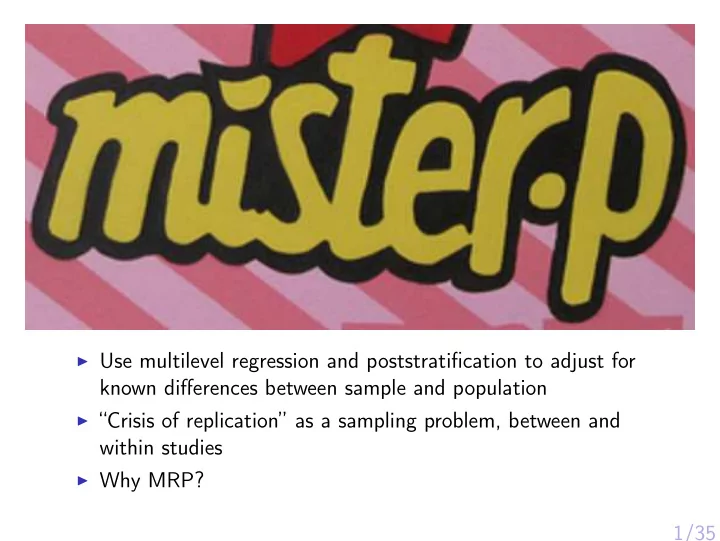

◮ Use multilevel regression and poststratification to adjust for known differences between sample and population ◮ “Crisis of replication” as a sampling problem, between and within studies ◮ Why MRP? 1/35
Generalizing from sample to population Andrew Gelman Department of Statistics and Department of Political Science Columbia University, New York Johns Hopkins School of Public Health 26 Feb 2016 2/35
3/35
4/35
5/35
“This week, the New York Times and CBS News published a story using, in part, information from a non-probability, opt-in survey sparking concern among many in the polling community. In general, these methods have little grounding in theory and the results can vary widely based on the particular method used.” — Michael Link, President, American Association for Public Opinion Research 6/35
7/35
8/35
Xbox estimates, adjusting for demographics 9/35
10/35
◮ Karl Rove, Wall Street Journal , 7 Oct: “Mr. Romney’s bounce is significant.” ◮ Nate Silver, New York Times , 6 Oct: “Mr. Romney has not only improved his own standing but also taken voters away from Mr. Obama’s column.” 11/35
Xbox estimates, adjusting for demographics and partisanship 12/35
Jimmy Carter Republicans and George W. Bush Democrats 13/35
14/35
15/35
16/35
Generalizing from sample to population! 17/35
18/35
19/35
20/35
The paradox of publication 21/35
The famous study of social priming 22/35
23/35
Daniel Kahneman (2011): “When I describe priming studies to audiences, the reaction is often disbelief . . . The idea you should focus on, however, is that disbelief is not an option. The results are not made up, nor are they statistical flukes. You have no choice but to accept that the major conclusions of these studies are true.” 24/35
25/35
The attempted replication 26/35
Daniel Kahneman (2011): “When I describe priming studies to audiences, the reaction is often disbelief . . . The Wagenmakers et al. (2014): idea you should focus “[After] a long series on, however, is that of failed replications disbelief is not an . . . disbelief does in fact option. The results are remain an option.” not made up, nor are they statistical flukes. You have no choice but to accept that the major conclusions of these studies are true.” 27/35
Alan Turing (1950): “I assume that the reader is familiar with the idea of extra-sensory perception, and the meaning of the four items of it, viz. telepathy, clairvoyance, precognition and psycho-kinesis. These disturbing phenomena seem to deny all our usual scientific ideas. How we should like to discredit them! Unfortunately the statistical evidence, at least for telepathy, is overwhelming.” 28/35
29/35
This week in Psychological Science ◮ “Turning Body and Self Inside Out: Visualized Heartbeats Alter Bodily Self-Consciousness and Tactile Perception” ◮ “Aging 5 Years in 5 Minutes: The Effect of Taking a Memory Test on Older Adults’ Subjective Age” ◮ “The Double-Edged Sword of Grandiose Narcissism: Implications for Successful and Unsuccessful Leadership Among U.S. Presidents” ◮ “On the Nature and Nurture of Intelligence and Specific Cognitive Abilities: The More Heritable, the More Culture Dependent” ◮ “Beauty at the Ballot Box: Disease Threats Predict Preferences for Physically Attractive Leaders” ◮ “Shaping Attention With Reward: Effects of Reward on Space- and Object-Based Selection” ◮ “It Pays to Be Herr Kaiser: Germans With Noble-Sounding Surnames More Often Work as Managers Than as Employees” 30/35
This week in Psychological Science ◮ N = 17 ◮ N = 57 ◮ N = 42 ◮ N = 7 , 582 ◮ N = 123 + 156 + 66 ◮ N = 47 ◮ N = 222 , 924 31/35
32/35
The “That which does not destroy my statistical significance makes it stronger” fallacy Charles Murray: “To me, the experience of early childhood intervention programs follows the familiar, discouraging pattern . . . small-scale experimental efforts [ N = 123 and N = 111] staffed by highly motivated people show effects. When they are subject to well-designed large-scale replications, those promising signs attenuate and often evaporate altogether.” James Heckman: “The effects reported for the programs I discuss survive batteries of rigorous testing procedures. They are conducted by independent analysts who did not perform or design the original experiments. The fact that samples are small works against finding any effects for the programs, much less the statistically significant and substantial effects that have been found.” 33/35
Adjusting for known differences between sample and population ◮ Include more predictors ◮ Multilevel regression ◮ Poststratification 34/35
Big Data need Big Model 35/35
Recommend
More recommend